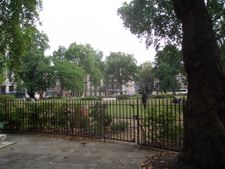
The Bloomsbury Group, a collective of aesthetes in early 20th century London, got their name from the section of Camden that surrounds Bloomsbury Square. The name is apparently derived from the many gardened squares that dot the neighborhoods. Thomas Wriothesley, the 4th Earl of Southampton, laid out the square in the 1660s. At the time this section of the city was home to the aristocracy, but by the 19th century it had become firmly middle class. The Darling family, in J.M. Barrie’s Peter Pan, lived on Bloomsbury Square. The area is also home to the British Museum, the Royal Academy of Dramatic Art and the University College of London.
Unlike the Darling family, the young artists and intellectuals of the Bloomsbury group were part of an emerging Modernist sensibility that was in many ways a reaction against the prevailing and increasingly suffocating Victorian aesthetic. While the contemporary Arts & Crafts movement looked back to the Middle Ages to find an alternative to the increasingly industrial material culture of the Victorian Era, the Modernists rebelled against the conformity and institutionalism of the mainstream by combining a Romantic embrace of individuality with a scientific evaluation of the self. Leonard and Virginia Woolf’s Hogarth Press brought out the first English translations of Freud’s work.

The members of the Bloomsbury Group were not famous when they began getting together to debate ethics and aesthetics in the first few years of the 20th century. The male members of the group had met at Trinity College, Cambridge, all mutual friends of Thoby Stephen, the brother of writer Virginia and painter Vanessa Stephen, who would later marry critics Leonard Woolf and Clive Bell, respectively. Other notable members included biographer Lytton Strachey, economist John Maynard Keynes and writer E.M. Forster.The artists and writers of Bloomsbury were generally from upper middle-class backgrounds. The Stephen siblings moved to Bloomsbury (Gordon Square, not Bloomsbury Square) from Kensington after the death of their father. It is their residence there and the centrality of Thoby Stephen to the social circle that gave the the group its name.
The Bloomsbury Group epitomized Modernism with its emphasis on individual experience, acute self-consciousness and questioning of establishment mores. The group espoused feminism, pacificism, open-marriage, and Freudian psychology.
The Cambridge alumni were influenced by G.E. Moore’s Principia Ethica (1903) and A.N. Whitehead and Bertrand Russell’s Principia Mathematica (1910-11). Moore coined the term “naturalistic fallacy” to describe philosophical arguments that attempted to prove that “good” could be defined by relating it to one or more natural properties that are already understood. Moore held that “good” is undefinable because it has no intrinsic natural properties. He argued that color is much the same – that saying “egg yolks are yellow” or “the wavelength between 570 and 590 nanometers is yellow” does not define “yellow.”

The Bloomsbury Group was interested in the discussion that began with the proposition that “Your behavior is natural; therefore your behavior is morally acceptable.” They would have none of it. They refused to take good as a natural property and thereby follow a morality based on a false connection between nature and goodness. In a sense their lives were experiments; they meant to find out what was “good” by defying conventional assumptions and trying out behaviors and social arrangements to see they freed the individual to grow and think in new ways. This, they hoped, was the essence of being human.
The naturalistic fallacy is related to the “is-ought” problem, which is the tendency to deduce an “ought” from an “is.” Once one has decided one has defined what good is, one can then describe a morality based on that (false) definition.
It is rather unsurprising that a group filled with homosexuals, bisexuals, post-Impressionist painters, socialists, and every other stripe of anti-establishmentarian would rather bridle at the idea that what was “natural” was “good.”
In 1864 Herbert Spencer gave the world the phrase “survival of the fittest” after reading Darwin’s theory of natural selection (published in 1859). Much of Spencer’s evolutionary thinking was actually based on Lamarckian ideas; unlike Darwin, he believed that life had a purpose and a direction. It was this sort of thinking that would lead to eugenics – and meet with objection in the Bloomsbury Group salons. Whereas Spencer attempted to recast Darwin’s ideas in a Victorian establishment mold, the Modernists, including the Bloomsbury Group, but especially the Huxleys, saw them for what they were: a complete demolition of an age-old idea of what it meant to be human.

You must be logged in to post a comment.